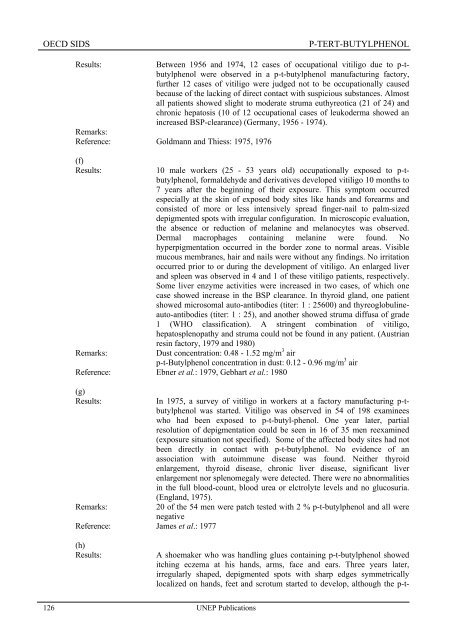p-Tert-Butylphenol - UNEP Chemicals
p-Tert-Butylphenol - UNEP Chemicals
p-Tert-Butylphenol - UNEP Chemicals
Create successful ePaper yourself
Turn your PDF publications into a flip-book with our unique Google optimized e-Paper software.
OECD SIDS P-TERT-BUTYLPHENOL<br />
126<br />
Results: Between 1956 and 1974, 12 cases of occupational vitiligo due to p-t-<br />
butylphenol were observed in a p-t-butylphenol manufacturing factory,<br />
further 12 cases of vitiligo were judged not to be occupationally caused<br />
because of the lacking of direct contact with suspicious substances. Almost<br />
all patients showed slight to moderate struma euthyreotica (21 of 24) and<br />
chronic hepatosis (10 of 12 occupational cases of leukoderma showed an<br />
increased BSP-clearance) (Germany, 1956 - 1974).<br />
Remarks:<br />
Reference: Goldmann and Thiess: 1975, 1976<br />
(f)<br />
Results: 10 male workers (25 - 53 years old) occupationally exposed to p-tbutylphenol,<br />
formaldehyde and derivatives developed vitiligo 10 months to<br />
7 years after the beginning of their exposure. This symptom occurred<br />
especially at the skin of exposed body sites like hands and forearms and<br />
consisted of more or less intensively spread finger-nail to palm-sized<br />
depigmented spots with irregular configuration. In microscopic evaluation,<br />
the absence or reduction of melanine and melanocytes was observed.<br />
Dermal macrophages containing melanine were found. No<br />
hyperpigmentation occurred in the border zone to normal areas. Visible<br />
mucous membranes, hair and nails were without any findings. No irritation<br />
occurred prior to or during the development of vitiligo. An enlarged liver<br />
and spleen was observed in 4 and 1 of these vitiligo patients, respectively.<br />
Some liver enzyme activities were increased in two cases, of which one<br />
case showed increase in the BSP clearance. In thyroid gland, one patient<br />
showed microsomal auto-antibodies (titer: 1 : 25600) and thyreoglobulineauto-antibodies<br />
(titer: 1 : 25), and another showed struma diffusa of grade<br />
1 (WHO classification). A stringent combination of vitiligo,<br />
hepatosplenopathy and struma could not be found in any patient. (Austrian<br />
resin factory, 1979 and 1980)<br />
Remarks: Dust concentration: 0.48 - 1.52 mg/m 3 air<br />
p-t-<strong>Butylphenol</strong> concentration in dust: 0.12 - 0.96 mg/m 3 air<br />
Reference: Ebner et al.: 1979, Gebhart et al.: 1980<br />
(g)<br />
Results: In 1975, a survey of vitiligo in workers at a factory manufacturing p-tbutylphenol<br />
was started. Vitiligo was observed in 54 of 198 examinees<br />
who had been exposed to p-t-butyl-phenol. One year later, partial<br />
resolution of depigmentation could be seen in 16 of 35 men reexamined<br />
(exposure situation not specified). Some of the affected body sites had not<br />
been directly in contact with p-t-butylphenol. No evidence of an<br />
association with autoimmune disease was found. Neither thyroid<br />
enlargement, thyroid disease, chronic liver disease, significant liver<br />
enlargement nor splenomegaly were detected. There were no abnormalities<br />
in the full blood-count, blood urea or elctrolyte levels and no glucosuria.<br />
(England, 1975).<br />
Remarks: 20 of the 54 men were patch tested with 2 % p-t-butylphenol and all were<br />
negative<br />
Reference: James et al.: 1977<br />
(h)<br />
Results: A shoemaker who was handling glues containing p-t-butylphenol showed<br />
itching eczema at his hands, arms, face and ears. Three years later,<br />
irregularly shaped, depigmented spots with sharp edges symmetrically<br />
localized on hands, feet and scrotum started to develop, although the p-t-<br />
<strong>UNEP</strong> Publications
















